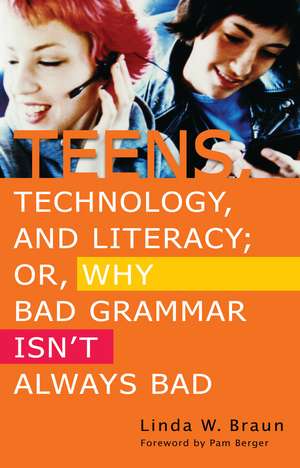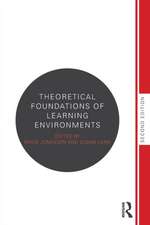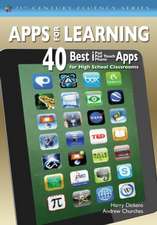Teens, Technology, and Literacy; Or, Why Bad Grammar Isn't Always Bad
Autor Linda W. Braunen Limba Engleză Paperback – 29 dec 2006 – vârsta până la 17 ani
Preț: 188.82 lei
Nou
Puncte Express: 283
Preț estimativ în valută:
36.13€ • 37.82$ • 30.07£
36.13€ • 37.82$ • 30.07£
Carte tipărită la comandă
Livrare economică 31 martie-14 aprilie
Preluare comenzi: 021 569.72.76
Specificații
ISBN-13: 9781591583684
ISBN-10: 1591583683
Pagini: 128
Dimensiuni: 156 x 235 x 10 mm
Greutate: 0.21 kg
Ediția:New.
Editura: Bloomsbury Publishing
Colecția Libraries Unlimited
Locul publicării:New York, United States
ISBN-10: 1591583683
Pagini: 128
Dimensiuni: 156 x 235 x 10 mm
Greutate: 0.21 kg
Ediția:New.
Editura: Bloomsbury Publishing
Colecția Libraries Unlimited
Locul publicării:New York, United States
Notă biografică
Linda W. Braun is a consultant and trainer for libraries and other educational institutions, a columnist for VOYA magazine, a curriculum and website developer, and the author of 5 books and numerous articles. She has also served as adjunct faculty in the LIS program at Simmons College and she is currently an adjunct faculty member at the Graduate School of Education, Lesley University.
Recenzii
Braun does educators, especially librarians, a great service by writing this book..Clear, consice, and intelligent, this volume is a treasure trove of information..For those not knowledgeable about wikis, blogs, and podcasts, this book offers good definitions and insight into their applications..Revelatory and sharp, this unique book offers a wonderful overview of the various technologies used by teens and supplies great material for educators as well. The many mind-expanding ideas offered by Braun are sure to guarantee positive interactions with teen students and library patrons.
The information in this book is explained simply and concisely, and is useful for anyone who both wants to know more about the new communication mediums..The book provides a wealth of information for the classroom teacher or librarian who wants to know more about the newer technologies and how to use them successfully with the this age group. Recommended.
This book presents tools, such as blogs, Wikis, podcasts, RSS (really simple syndication or rich site survey), and IM (instant messaging)-all powerful communication tools for teens in addition to being useful tools for literacy. Braun encourages readers to embrace these technologies and provides many sound explanations as to why and how they support literacy for students..She also offers suggestions for collaborative student projects, including creating a Wiki around a report or writing and producing a podcast. There are numerous example of sites that readers can visit to see examples of the technology in use. Appendixes list Web-based content-creation tools as well as information on finding blogs and podcasts. A third appendix lists other useful resources for keeping up with technology. This is a valuable tool for anyone interested in increasing his or her knowledge of new technologies and using these technologies to improve programming and curriculum.
Braun shows teachers, administrators, and librarians how to incorporate today's technologies into the development of literacy skills. The author backs up the grammar used in IMs and text messaging by explaining how these technologies promote better literacy in the classroom. She takes readers through literacy as it has been defined in the past and how it is being redefined for 21st-century learners. She also provides ideas for hands-on experience for using the new technologies in libraries or classrooms by giving links and examples of technology in action and its relationship to literacy. While the screen captures are blurry, Braun provides the link below the screen to view the actual site. Additional resources and uses for all the new technologies discussed are appended. This book is a must for most collections.
Braun explores the ways teens communicate in cyberspace, considering how the various technologies affect literacy and communication habits and skills. The author believes that, in spite of the commonality of bad grammar, acronyms, and poor spelling, communication via instant messaging, email, and podcasting is creating a new community of learning and is a boon to literacy. Here, she supports these findings and offers strategies to librarians and educators for taking advantage of the type of learning those technologies encourage.
The information in this book is explained simply and concisely, and is useful for anyone who both wants to know more about the new communication mediums..The book provides a wealth of information for the classroom teacher or librarian who wants to know more about the newer technologies and how to use them successfully with the this age group. Recommended.
This book presents tools, such as blogs, Wikis, podcasts, RSS (really simple syndication or rich site survey), and IM (instant messaging)-all powerful communication tools for teens in addition to being useful tools for literacy. Braun encourages readers to embrace these technologies and provides many sound explanations as to why and how they support literacy for students..She also offers suggestions for collaborative student projects, including creating a Wiki around a report or writing and producing a podcast. There are numerous example of sites that readers can visit to see examples of the technology in use. Appendixes list Web-based content-creation tools as well as information on finding blogs and podcasts. A third appendix lists other useful resources for keeping up with technology. This is a valuable tool for anyone interested in increasing his or her knowledge of new technologies and using these technologies to improve programming and curriculum.
Braun shows teachers, administrators, and librarians how to incorporate today's technologies into the development of literacy skills. The author backs up the grammar used in IMs and text messaging by explaining how these technologies promote better literacy in the classroom. She takes readers through literacy as it has been defined in the past and how it is being redefined for 21st-century learners. She also provides ideas for hands-on experience for using the new technologies in libraries or classrooms by giving links and examples of technology in action and its relationship to literacy. While the screen captures are blurry, Braun provides the link below the screen to view the actual site. Additional resources and uses for all the new technologies discussed are appended. This book is a must for most collections.
Braun explores the ways teens communicate in cyberspace, considering how the various technologies affect literacy and communication habits and skills. The author believes that, in spite of the commonality of bad grammar, acronyms, and poor spelling, communication via instant messaging, email, and podcasting is creating a new community of learning and is a boon to literacy. Here, she supports these findings and offers strategies to librarians and educators for taking advantage of the type of learning those technologies encourage.














